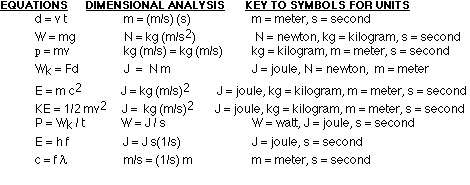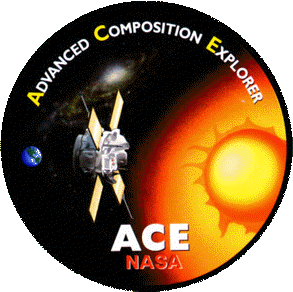
Constants:
Acceleration of Gravity (g) = 9.8 m/s2
Speed of Light (c) = 3 x 108 m/s
Mass of Electron = 9.1 x 10-31 kg
Mass of Proton = 1.67 x 10-27 kg
Planck’s constant (h) = 6.63 X 10 -34 J s
Variables (found in the equations listed above):
Background:
The ACE (Advanced Composition Explorer) spacecraft was launched in August of 1997 to make observations that are being used to test current theories on the
creation and evolution of the galaxy. It is the purpose of the ACE spacecraft to sample the matter that
comes near the Earth from the Sun, the space between the planets, and the Milky Way galaxy beyond the solar
system. The ACE spacecraft contains nine instruments which have varying capabilities to measure
particle types, charge, mass, energy, direction of travel, and time of arrival to the spacecraft. The nine
instruments work simultaneously to create a comprehensive view of the particles which stream past
ACE. Data from ACE is contributing to our understanding of the
origin and evolution of the solar system and the processes involved. During its first year ACE has already collected more data on many
isotopes in ACE’s energy range than all previous instruments combined.
The ACE instruments are performing measurements of particles and cosmic rays over a wide range of energies and nuclear masses. The energy unit used is the electron volt (eV). The eV is handy for stating the energies of elementary particles since they have very small amounts of energy. The proper SI unit for energy is the joule (J). For many physics calculations it is necessary to convert electron volts to joules.
The solar wind leaves the Sun’s corona at about one million degrees Kelvin. On its way to the Earth, expansion occurs and the solar wind cools. Even so, temperatures of a few hundred thousand degrees are common. While reading the temperatures on the ACE/SWEPAM plots in part one of this investigation it is important to understand that this does not imply that the temperature of interstellar space is that temperature. It is the plasma within the solar wind that is at that temperature. Since the density of particles in this region is much less than even the air in our Earth atmosphere, heat transfer is almost nonexistent. To access a site which shows a comparison of their densities go to the following address: http://www.windows.umich.edu:80/spaceweather/images/solar_wind_density_jpg_image.html
The ACE mission is important because of the ability of its instruments to study the origin and evolution of the elements. ACE detects many of the heavier isotopes which originated during the formation, evolution, and subsequent explosion of stars. The comparative number of different isotopes found in the galaxy is thought to be related to the life cycle of the massive stars. It is important here to keep in mind that the material that the Earth and the rest of the solar system are made of has been changed and rearranged throughout the billions of years since their creation, so measuring its complete composition is difficult. ACE is measuring cosmic ray particles to draw comparisons between matter from the solar system (Sun, meteorites, planets, atmospheres of planets, the moon), comets, the local interstellar medium, and the galaxy. It is hoped that these comparisons will help answer some of the questions which astronomers have about the creation and evolution of the galaxy.
To access a tremendous web site that has a glossary of space science terminology go to the Cosmicopia glossary
To solve the problems in this investigation use the following physics equations, constants, and conversion factors.
Summary of Equations (including dimensional
analysis):

Constants:
Acceleration of Gravity (g) = 9.8 m/s2
Speed of
Light (c) = 3 x 108 m/s
Mass of Electron = 9.1 x 10-31 kg
Mass of
Proton = 1.67 x 10-27 kg
Planck’s constant (h) = 6.63 X 10 -34 J s
Variables (found in the equations listed above):

Conversion Factors:
![]()

PART ONE:
The ACE/SWEPAM instrument collects data on solar wind plasma electron and ion fluxes (the
rate of particle flow). In addition, SWEPAM provides real-time observations of solar wind temperature, and radial speed (speed of the solar wind moving away from the Sun). These observations are
continuously sent to the ground for space weather purposes. Follow the directions below to access SWEPAM
live-time data and answer the associated questions.
1. Access the ACE Project page at http://www.srl.caltech.edu/ACE/
2. Click ONLINE DATA.
3. Click the Real
Time button. (This takes you to the ACE real time solar wind page.)
4. Click on
“ACE Real-Time Solar Wind (RTSW) Data”
5. Click on “ACE Plots” found
below Real Time Data on the left of your display. You can now select the RTSW data (ACE instrument)
which you want to plot and the window scale (time) for your plot. The first window below Select
ACE RTSW Data to Plot allows you to choose which ACE instrument data set you want to plot. The second
window below Select ACE RTSW Data to Plot allows you to choose the time interval you want to look at.
6. To begin, click and hold the arrow in the first window below Select ACE RTSW Data
to Plot.
7. Drag down until you highlight SWEPAM.
8. Click and hold the arrow in the second window below Select ACE RTSW Data to Plot.
9. Drag down until you highlight 7-day (1-min or 5-min data).
10. Click and
release on the Start Plot button to begin plotting SWEPAM data collected over the last 7 days.
Answer the following:
PART ONE QUESTIONS
1. THE GRAPH provides ACE/SWEPAM data about the solar wind over the past seven days.
2. The average solar wind speed is 400 km/s.
3. The y-axis of the temperature graph is shown as a
logarithmic
plot. The dashed white line which extends across the bottom plot corresponds with 100,000 degrees kelvin
and is shown as 1.0 E +05. (This is called E-notation or exponential notation. The E +05 represents
ten raised to the power of five or 1 x 10 5.) The next short line above it corresponds with 200,000 degrees
kelvin, then 300,0000 degrees kelvin and so on. The line at the top corresponds with 1,000,000
degrees kelvin and is shown as 1.0 E +6. (For a more complete explanation of logarithmic plots
access the following link.)
http://tutor.lscf.ucsb.edu/instdev/sears/biochemistry/tw-lig/logarithms/logarithmic-axes.htm
4. Using the Educational Brief on Cosmology and Stellar
Evolution listed in the abstract above, compare the temperatures of the solar wind that you observed
on the graphs in question #3 with the temperatures of stars at various stages of their life history.
Your comparison should list:

PART TWO:
Each of the following questions provides
information about the ACE spacecraft, its instruments, the solar wind, or other specific
solar events. Solve each problem using the given information and the appropriate physics equations,
constants, or conversion factors listed in the background information. (See the Teacher Resources
for answers to these questions.)
PHYSICS PROBLEMS
(BY TOPIC)
CONVERSION FACTORS
1. The ACE spacecraft has the following dimensions: 1.60 m across by 1.00 m high
2. The molecules in our atmosphere have typical energies of around 0.0300 eV.
3. The solar wind compresses the day-side of the magnetosphere to a distance as
short as 6 times the radius of Earth.
4. On the
night-side, the solar wind drags out the magnetosphere to possibly 1000 times the Earth’s radius.
5. Use your answers from #3 and #4 above.
KINEMATICS
1. The ACE spacecraft is orbiting at the libration point, L1, at about 1.50 million km from Earth. How long would
it take to reach that location if you could travel:
2. The average speed of the solar wind is 400 km/s.
3. The average distance from the Earth to the Sun is 93,000,000
mi (solar wind average speed = 400 km/s).
4. Isotopes of He found within the solar wind can achieve speeds
of 1,500 km/s.
5. The ACE/SWICS instrument measures solar wind particle
speeds ranging from 145 km/s (protons) to 1532 km/s (iron).
WEIGHT/MASS
1. The ACE spacecraft was launched with a mass of 785 kg
(including 195 kg of fuel).
2. A
coronal mass ejection (CME) releases up to 100 billion kg of solar mass above the corona.
MOMENTUM
1. The ACE/SWICS instrument detects protons with speeds ranging
from 145 km/s to 1532 km/s.
2. The mass of an electron is 9.11 X 10 -31 kg. A CME can accelerate
electrons to speeds of up to 1000 km/s.

WORK, POWER, AND ENERGY
1. The ACE spacecraft requires 443 W of power to
run its instruments. The power is provided by four fixed solar arrays.
2. The EPAM instrument measures particles with kinetic energies in the range of 30.0 keV/nucleon
up to 4.00 MeV/nucleon.
3. The ACE/ULEIS instrument can detect protons with kinetic energies as high as .320 MeV/nucleon. Protons in the Earth’s
magnetosphere have energies as high as 10.0 keV/nucleon.
4. ACE instruments detect protons. The mass of a proton is 1.67 x 10 -27 kg.
5. Protons detected by ULEIS may have a kinetic energy of .350 Mev.
6. The purpose of the ACE spacecraft is to sample the matter that comes near the Earth from the Sun, the
space between the planets, and the Milky Way galaxy beyond the solar system. In addition to matter
emitted by stars, visible light is also emitted.

Investigation Discussion and Questions
1. List instances where the work being done by scientists who
are working on the cutting edge of space science relates directly to the topics that you have studied
in physics.
2. The ACE spacecraft was launched to make observations that are
being used to test current theories on the creation and evolution of the galaxy. Access the "Cosmology and Stellar Evolution" Education Brief, related to ACE and the evolution of stars, to read about those topic. Develop a speech regarding why we should study particles in space.
3. Develop an outline or poster depicting the history of our sun and a prediction on its probable future. Base your outline or poster upon the information, provided in "Cosmology and Stellar Evolution" Education Brief, on ACE and the evolution of stars.
Teacher Resources
Part Two Answers
CONVERSION FACTORS:
1. 1600 mm across and 1000 mm high
160 cm across and 100 cm high
.0016 km across and
.001 km high
2. 4.81 x 10 -21 J
4.81 x 10 -21 J
3. 38,400 km
38,400,000 m
4. 6,400,000 km
6,400,000,000 m
5. 6,438,400 km
6,438,400,000 m
KINEMATICS:
1. 647 days
5 s
2 900,000 mi/hr
3. 4.31 days
4. 1.15 days
5. 522,000 km for 145 km/s
5,515,200 km
for 1532 km/s
WEIGHT/MASS:
1. 7,693 N
2. Thirteen orders of magnitude separate the two.
MOMENTUM:
1. 2.42 x 10 -2 kgm/s for the 145 km/s protons
2.56 x 10 -21 kgm/s for
the 1532 km/s protons
2. 9.11 x 10 -25 kgm/s
WORK/POWER/ENERGY:
1. 1.59 x 106 J
.576 m
2. 4,81 x 10-15 J/nucleon to 6.41x 10-13 J/nucleon
Two orders of magnitude separate
the two.
3. 5.13 x 10-14 J/nucleon for ULEIS protons and 1.62 x 10-15
J/nucleon for magnetosphere protons
The ULEIS nucleons are one order of magnitude more energetic.
4. 5.01 x 10-19 J
5. 5.54 x 103
km/s
6. 3.06 x 10 -19 J
Coding:
Maryland Core Learning Goals (Science): 2:1:2, 2:2:1, 2:3:1
National Standards (Science):
physical science grades 9-12, standards #2, 6
Earth and Space Science grades 9-12, standard #4
National Standards (Geography): standard #8, indicator 2
National Standards (Mathematics): #1.2, 2.1,4.4, 5.2, 6.1, 6.6, 10.1
Feedback:
Goddard Scientists: Dr. Eric R. Christian <cosmicopia@cosmicra.gsfc.nasa.gov>,
Dr. John Krizmanic <cosmicopia@cosmicra.gsfc.nasa.gov>, Beth
Barbier<cosmicopia@cosmicra.gsfc.nasa.gov>
Credits:
Daniel Hortert
GESSEP Program
Pat Keeney GESSEP Program
Dr. Eric R.
Christian ACE Deputy Project
Scientist
Dr. John Krizmanic Astroparticle
Physicist
Beth Barbier ACE Outreach Specialist